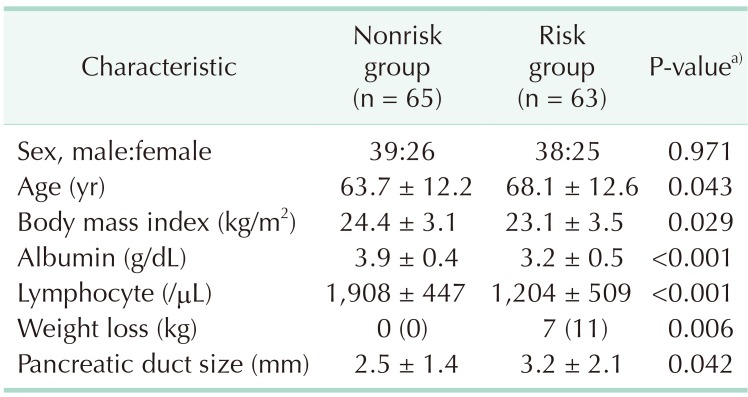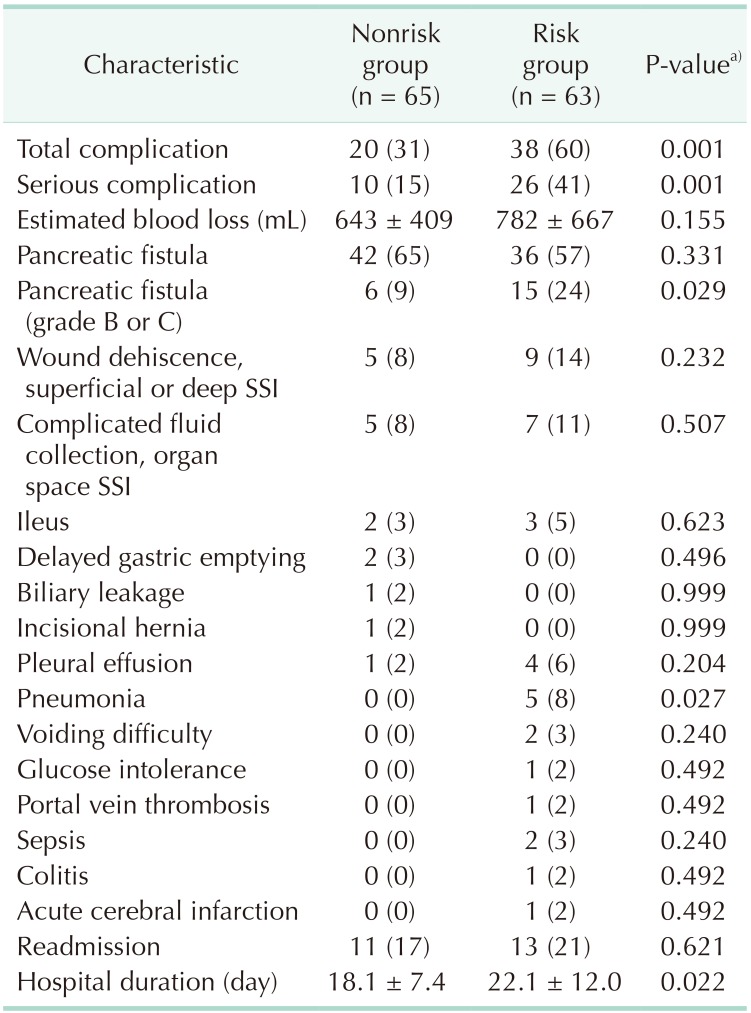1. McWhirter JP, Pennington CR. Incidence and recognition of malnutrition in hospital. BMJ. 1994; 308:945–948. PMID:
8173401.

2. Velasco C, Garcia E, Rodriguez V, Frias L, Garriga R, Alvarez J, et al. Comparison of four nutritional screening tools to detect nutritional risk in hospitalized patients: a multicentre study. Eur J Clin Nutr. 2011; 65:269–274. PMID:
21081958.

3. Afaneh C, Gerszberg D, Slattery E, Seres DS, Chabot JA, Kluger MD. Pancreatic cancer surgery and nutrition management: a review of the current literature. Hepatobiliary Surg Nutr. 2015; 4:59–71. PMID:
25713805.
4. La Torre M, Ziparo V, Nigri G, Cavallini M, Balducci G, Ramacciato G. Malnutrition and pancreatic surgery: prevalence and outcomes. J Surg Oncol. 2013; 107:702–708. PMID:
23280557.

5. Ahmad SA, Edwards MJ, Sutton JM, Grewal SS, Hanseman DJ, Maithel SK, et al. Factors influencing readmission after pancreaticoduodenectomy: a multi-institutional study of 1302 patients. Ann Surg. 2012; 256:529–537. PMID:
22868373.
6. Zhou W, Xu X, Yan J, Mou Y. Nutritional risk is still a clinical predictor of postoperative outcomes in laparoscopic abdominal surgery. Surg Endosc. 2013; 27:2569–2574. PMID:
23392976.

7. White JV, Guenter P, Jensen G, Malone A, Schofield M, et al. Academy of Nutrition and Dietetics Malnutrition Work Group. Consensus statement of the Academy of Nutrition and Dietetics/American Society for Parenteral and Enteral Nutrition: characteristics recommended for the identification and documentation of adult malnutrition (undernutrition). J Acad Nutr Diet. 2012; 112:730–738. PMID:
22709779.

8. Ferguson M. Patient-generated subjective global assessment. Oncology (Williston Park). 2003; 17(2 Suppl 2):13–14.
9. Detsky AS, McLaughlin JR, Baker JP, Johnston N, Whittaker S, Mendelson RA, et al. What is subjective global assessment of nutritional status. JPEN J Parenter Enteral Nutr. 1987; 11:8–13. PMID:
3820522.

10. Bauer J, Capra S, Ferguson M. Use of the scored Patient-Generated Subjective Global Assessment (PG-SGA) as a nutrition assessment tool in patients with cancer. Eur J Clin Nutr. 2002; 56:779–785. PMID:
12122555.

11. Ottery FD. Definition of standardized nutritional assessment and interventional pathways in oncology. Nutrition. 1996; 12(1 Suppl):S15–S19. PMID:
8850213.

12. Kondrup J, Allison SP, Elia M, Vellas B, Plauth M, et al. Educational and Clinical Practice Committee. ESPEN guidelines for nutrition screening 2002. Clin Nutr. 2003; 22:415–421. PMID:
12880610.

13. Cameron JL, Riall TS, Coleman J, Belcher KA. One thousand consecutive pancreaticoduodenectomies. Ann Surg. 2006; 244:10–15. PMID:
16794383.

14. Ansorge C, Lindstrom P, Strommer L, Blomberg J, Lundell L, Andren-Sandberg A, et al. Assessing surgical quality: comparison of general and procedure-specific morbidity estimation models for the risk adjustment of pancreaticoduodenectomy outcomes. World J Surg. 2014; 38:2412–2421. PMID:
24705780.

15. Hackert T, Hinz U, Pausch T, Fesenbeck I, Strobel O, Schneider L, et al. Postoperative pancreatic fistula: we need to redefine grades B and C. Surgery. 2016; 159:872–877. PMID:
26603847.

16. Kimura W, Miyata H, Gotoh M, Hirai I, Kenjo A, Kitagawa Y, et al. A pancreaticoduodenectomy risk model derived from 8575 cases from a national single-race population (Japanese) using a web-based data entry system: the 30-day and inhospital mortality rates for pancreaticoduodenectomy. Ann Surg. 2014; 259:773–780. PMID:
24253151.
17. Schmidt CM, Turrini O, Parikh P, House MG, Zyromski NJ, Nakeeb A, et al. Effect of hospital volume, surgeon experience, and surgeon volume on patient outcomes after pancreaticoduodenectomy: a single-institution experience. Arch Surg. 2010; 145:634–640. PMID:
20644125.
18. Greenblatt DY, Kelly KJ, Rajamanickam V, Wan Y, Hanson T, Rettammel R, et al. Preoperative factors predict perioperative morbidity and mortality after pancreaticoduodenectomy. Ann Surg Oncol. 2011; 18:2126–2135. PMID:
21336514.

19. Roberts KJ, Sutcliffe RP, Marudanayagam R, Hodson J, Isaac J, Muiesan P, et al. Scoring system to predict pancreatic fistula after pancreaticoduodenectomy: a UK multicenter study. Ann Surg. 2015; 261:1191–1197. PMID:
25371115.
20. Muscari F, Suc B, Kirzin S, Hay JM, Fourtanier G, Fingerhut A, et al. Risk factors for mortality and intra-abdominal complications after pancreatoduodenectomy: multivariate analysis in 300 patients. Surgery. 2006; 139:591–598. PMID:
16701090.

21. Sato N, Tamura T, Minagawa N, Hirata K. Preoperative body mass index-to-prognostic nutritional index ratio predicts pancreatic fistula after pancreaticoduodenectomy. Hepatobiliary Surg Nutr. 2016; 5:256–262. PMID:
27275468.

22. Sierzega M, Niekowal B, Kulig J, Popiela T. Nutritional status affects the rate of pancreatic fistula after distal pancreatectomy: a multivariate analysis of 132 patients. J Am Coll Surg. 2007; 205:52–59. PMID:
17617332.

23. Melis M, Marcon F, Masi A, Pinna A, Sarpel U, Miller G, et al. The safety of a pancreaticoduodenectomy in patients older than 80 years: risk vs. benefits. HPB (Oxford). 2012; 14:583–588. PMID:
22882194.

24. Tani M, Kawai M, Hirono S, Ina S, Miyazawa M, Nishioka R, et al. A pancreaticoduodenectomy is acceptable for periampullary tumors in the elderly, even in patients over 80 years of age. J Hepatobiliary Pancreat Surg. 2009; 16:675–680. PMID:
19387530.
25. Lee MK, Dinorcia J, Reavey PL, Holden MM, Genkinger JM, Lee JA, et al. Pancreaticoduodenectomy can be performed safely in patients aged 80 years and older. J Gastrointest Surg. 2010; 14:1838–1846. PMID:
20824366.

26. Kim JH, Min SK, Lee H, Hong G, Lee HK. The safety and risk factors of major hepatobiliary pancreatic surgery in patients older than 80 years. Ann Surg Treat Res. 2016; 91:288–294. PMID:
27904850.

27. Dindo D, Demartines N, Clavien PA. Classification of surgical complications: a new proposal with evaluation in a cohort of 6336 patients and results of a survey. Ann Surg. 2004; 240:205–213. PMID:
15273542.
28. Bassi C, Dervenis C, Butturini G, Fingerhut A, Yeo C, Izbicki J, et al. Postoperative pancreatic fistula: an international study group (ISGPF) definition. Surgery. 2005; 138:8–13. PMID:
16003309.

29. Martin RC 2nd, Brennan MF, Jaques DP. Quality of complication reporting in the surgical literature. Ann Surg. 2002; 235:803–813. PMID:
12035036.






 PDF
PDF ePub
ePub Citation
Citation Print
Print






 XML Download
XML Download